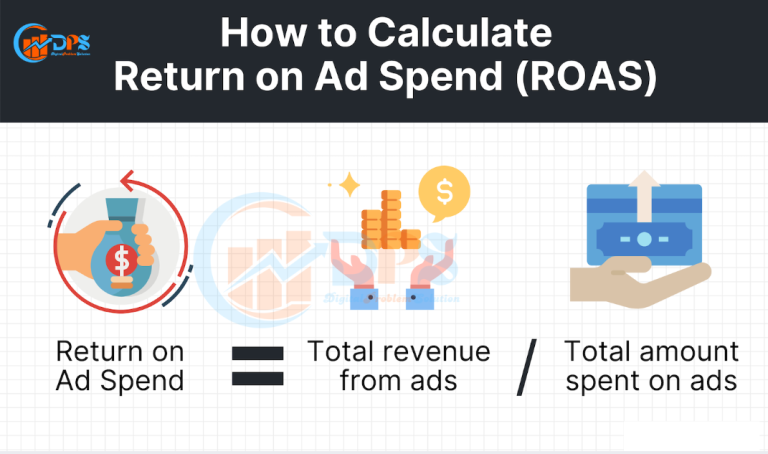Return on Ad Spend (ROAS)
Return On Ad Spend (ROAS) Mastery Explained: Guaranteed Growth
Social Share

Maximizing Returns: Understanding Return on Ad Spend (ROAS)
In the ever-evolving landscape of digital marketing, where every click counts and every conversion matters, businesses are increasingly turning to sophisticated metrics to gauge the effectiveness of their advertising efforts. One such metric that has gained significant traction is Return on Ad Spend (ROAS). ROAS serves as a compass guiding advertisers through the intricate maze of online advertising, helping them optimize their strategies to maximize returns on their investments.
Defining ROAS:
Return on Ad Spend (ROAS) is a fundamental metric used by advertisers to measure the revenue generated for every dollar spent on advertising. It provides insights into the effectiveness of advertising campaigns by quantifying the relationship between advertising expenditure and revenue generated. Essentially, ROAS helps advertisers answer the crucial question: “For every dollar spent on advertising, how much revenue did it generate?”
Calculating ROAS:
ROAS is calculated by dividing the total revenue generated from advertising by the total amount spent on advertising. The formula for ROAS is as follows:
ROAS = Total Revenue from Advertising\ Total Ad Spend
For example, if a business spends $10,000 on advertising and generates $50,000 in revenue attributed to those ads, the ROAS would be 5 ($50,000 / $10,000).
Interpreting ROAS:
A ROAS value greater than 1 indicates that the advertising efforts are yielding positive returns, with revenue generated exceeding the amount spent on advertising. For instance, a ROAS of 5 means that for every dollar spent on advertising, $5 in revenue is generated.
On the other hand, a ROAS value less than 1 suggests that the advertising efforts are not generating sufficient returns to justify the expenditure. In such cases, advertisers may need to reassess their strategies, optimize targeting, refine messaging, or allocate budgets more effectively to improve ROAS.
Importance of ROAS:
ROAS is a critical metric for advertisers for several reasons:
1. Budget Allocation: By understanding which advertising channels and campaigns deliver the highest ROAS, advertisers can allocate their budgets more efficiently, focusing resources on strategies that yield the best returns.
2. Performance Evaluation: ROAS provides a clear and concise measure of advertising performance. It enables advertisers to assess the effectiveness of their campaigns in driving revenue and adjust strategies accordingly.
3. Optimization: Armed with ROAS data, advertisers can optimize various aspects of their campaigns, such as audience targeting, ad creatives, and bidding strategies, to enhance overall performance and maximize returns.
4. ROI Maximization: Ultimately, the goal of any advertising campaign is to maximize return on investment (ROI). ROAS serves as a valuable tool in this endeavor, allowing advertisers to identify opportunities for improving ROI by increasing revenue or reducing advertising costs.
Factors Influencing ROAS:
Several factors can influence the ROAS of advertising campaigns:
1. Target Audience: The relevance and responsiveness of the target audience to the advertising message significantly impact ROAS. Effective targeting ensures that advertising dollars are spent on reaching individuals most likely to convert.
2. Ad Quality: Compelling ad creatives that resonate with the audience can improve click-through rates and conversion rates, ultimately boosting ROAS.
3. Conversion Funnel: The effectiveness of the conversion funnel, from initial engagement to final purchase or action, plays a crucial role in determining ROAS. Streamlining the conversion process can lead to higher returns on ad spend.
4. Seasonality and Market Trends: External factors such as seasonality, market trends, and competitive landscape can influence consumer behavior and, consequently, ROAS. Advertisers need to adapt their strategies to capitalize on opportunities and mitigate risks.
Return on Ad Spend (ROAS) serves as a compass guiding advertisers through the complex terrain of digital advertising, helping them navigate towards profitability and success. By measuring the revenue generated for every dollar spent on advertising, ROAS empowers advertisers to make informed decisions, optimize strategies, and maximize returns on their investments. In an era where data reigns supreme, ROAS emerges as a cornerstone metric for driving advertising effectiveness and achieving sustainable growth in the digital age.
- admin
- February 6, 2024
- 1:05 pm
- 8 Comments
Share This Article on Social Media
Facebook
Twitter
LinkedIn
Reddit
Email
Recent Topic
Finding Best Ai Marketers How To Find The Best AI Marketers Social Share How To Find The Best AI Marketers: A Guide To...
Top News
Weekly News
















8 thoughts on “Return on Ad Spend (ROAS) Mastery Explained: Guaranteed Growth”
Your point of view caught my eye and was very interesting. Thanks. I have a question for you.
I’m glad you found my perspective intriguing! Please, feel free to ask your question, and I’ll do my best to respond with insight and intelligence.
Return on Ad Spend (ROAS) serves as a compass guiding advertisers through the complex terrain of digital advertising, helping them navigate towards profitability and success.
Can you be more specific about the content of your article? After reading it, I still have some doubts. Hope you can help me. https://www.binance.com/sl/register?ref=OMM3XK51
Thanks for sharing. I read many of your blog posts, cool, your blog is very good. https://accounts.binance.com/el/register?ref=IQY5TET4
Thanks for sharing. I read many of your blog posts, cool, your blog is very good. https://accounts.binance.com/fr-AF/register?ref=JHQQKNKN
Thanks for sharing. I read many of your blog posts, cool, your blog is very good.
Thank you very much. Keep following to know more.🙂